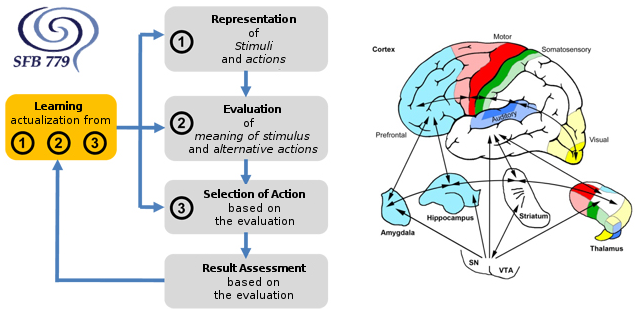CRC 779: Overview
Motivation is a fundamental factor eliciting and controlling behavior in higher animals, including humans. Specifically, it is at the basis of all goal-oriented decision-making through humans' entire lifespan. Motivation is therefore of central interest not only for the life sciences and clinical research, but also of highest societal relevance. While theories of the nature of motivation have a century-long history in psychology and the social sciences, the systematic exploration of brain mechanisms underlying motivation has begun only relatively recently. More...

Left: representative diagram of commonly accepted elementary processes of motivationally regulated decisions (including the motivation-dependent modulation of sensory systems as focused on by CRC; modified after Rangel et al., 2008). Right: Network of selected relevant brain structures in primates, considering as example the motivation-dependent stimulus representation of auditory signals. The figure focusses on the interconnectedness of the auditory cortex that has led to the concept of the "semantic processor" (see Scheich et al., 2011). Competing hypotheses regarding the neuronal implementation on the systemic and molecular level as well as modulation of the elementary processes by experience and learning do characterize the field of research (abbreviations: Substantia nigra, VTA: Area tegmentalis ventralis).
The CRC 779 "Neurobiology of motivated behavior" investigates the neuronal bases of motivational processes with an interdisciplinary approach that exploits the complementary advantages of animal and human research. It has established a network of closely interacting researchers from the Magdeburg University, the University Hospital/Medical Faculty, the Leibniz Institute for Neurobiology and the German Center for Neurodegenerative Diseases - Site Magdeburg that transgresses classical academic disciplines. Combination of brain circuit analyses in rodents with imaging approaches in humans produces novel insights into the functional architecture of brain systems mediating motivation-based behaviors. Molecular analyses investigate cellular signaling during motivational processes and proteomic screening approaches identify molecules that are differentially regulated by different forms of motivation. This form of concept-based integration of contributions from different scientific disciplines yields a deepened understanding of the neuronal basis of motivation and allows the translation into clinical applications, including the new opportunities for treating several kinds of neuropsychiatric diseases.
The CRC 779 has become an important determinant for structural development of the Magdeburg neuroscience landscape. Both, university and state of Saxony-Anhalt have defined the Neurosciences as a focus topic of research and support. Consequently, during its first two funding periods, the CRC 779 not only has attracted established researchers from near and abroad as new members, but also has taken measures of sustained early career support in this fast developing scientific field by implementing an Integrated Research Training Group and establishing new young-investigators' groups.